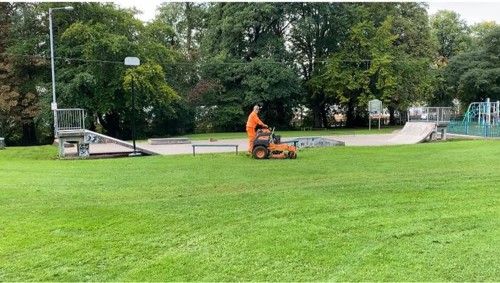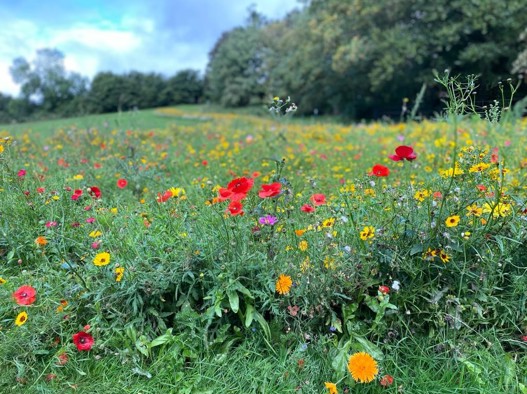- Caring for Green Spaces
Caring for Green Spaces
Mowing
The areas we mow include parks, open spaces, cemeteries, the crematorium, selected gardens, general housing amenity areas, sheltered housing schemes and highway verges. In addition to mowing the teams undertake a schedule of maintenance work to the seasonal beds, shrub beds and other green areas in Broxtowe Borough Council’s control.
There are nearly 200 hectares of parks and open spaces to maintain in Broxtowe. Not all these are grass areas but this puts in perspective the areas that need to be maintained. The majority of this is cut by tractors with large mowers that are very efficient and can cut large areas of grass to a high standard. This is particularly important when maintaining sports outfields.
Our parks and open spaces are generally mown every two weeks from April to October, depending on weather conditions. This is to create accessible open spaces that are attractive and provide space for people to enjoy active recreation in Broxtowe.
The highway verges are mown five times a year and this is based on a frequency set by Via East Midlands, the contracting arm of Nottinghamshire County Council as we maintain these on their behalf.
Mowing is undertaken for a number of reasons:
- To create accessible green spaces
- To help with safety by cutting vegetation at road junctions
- To make areas feel more welcoming and appealing
More relaxed mowing regimes are now being introduced at many green spaces across the Borough. We work hard to achieve the correct balance to create mown areas of grassland for people to actively enjoy for their recreation alongside a more relaxed approach to mowing to help improve biodiversity in the Borough.
Enhanced Land
As part our Climate Change and Green Futures project, we are working to improve natural corridors by changing our approach to grass cutting in some areas. We are sowing and planting more seeds and plants to create more areas with annuals for bees and pollinating insects. 
Areas improved in 2020 include:
- Sowing of flowers at Archers Field Recreation Ground, Stapleford
- New areas of flower annuals at Awsworth, Chilwell, Eastwood, Nuthall and Watnall.
You may have seen these areas in flower recently. As we look to increase the amount of areas, it is not simply a case of not cutting the grass and the flowers then appear. Areas need to have the grass collected at the end of the season, problem weeds need to be controlled, additional seeding or plug planting may also be required. No two areas are the same and before adopting a change in the mowing regime, it is important to consider what we want to achieve and the impact that it will have on the people who use the area.
These changes are alongside all of the areas that have previously been created or where maintenance regimes have been altered. Popular sites include the Ikea Island at the A610 in Giltbrook, the areas of bird feeding crops at Brinsley Headstocks and Colliers Wood. Some green areas are out of our control but even in these areas, we work with land owners to encourage them to adopt a sensitive approach to land management.
Some of the plants in the annual mixes we use may be found “wild” in parts of the world, but are not all native to the British Isles. We carefully select the variety of flowers and plants to offer a nectar source in the summer months, when the bees and pollinators are most active. They also provide a wave of colour, which residents enjoy and have said they feel improves their general wellbeing throughout the year. We will be changing our terminology used to describe these areas.
There are however many other more natural wildflower meadows on our green spaces which are being managed in a traditional way.
Hay Meadows
At Colliers Wood and Brinsley Headstocks Local Nature Reserves, a significant proportion of the grassland is now being managed as hay meadow to benefit biodiversity. Path edges are cut regularly and grass tracks are mown through the meadows to allow people to enjoy them. There are still mown areas of grass to kick a ball, let the dogs run or have a picnic but some areas are being managed in a different way, to benefit wildlife.
From late summer to early autumn, the hay meadows are cut and the grass collected into rows ready for baling. In 2020, the hay was baled and has been left on site in selected locations to compost naturally. The bales have been carefully placed and located securely along the boundaries of the sites and as the hay slowly decomposes, bacterial activity gives off a small amount of heat. Reptiles are able to take advantage of this warmth when choosing a site for egg laying. This provides an incredible habitat for a rich variety of plants and animals.
Throughout the autumn and early winter, Friends groups are introducing seed of once common native wild flowers into the meadows, further enhancing biodiversity. An ongoing record of the species found at the sites is made and as time passes there should be an increase in the variety and number of wild plants and animals, helping protect the meadows for future generations. Already wild orchids have been recorded at both sites and butterfly numbers have increased.
Winter Work
Did you know our land management work doesn’t stop in the winter? Our grounds teams are busy all year round. Here are just a few of the things our team is doing when the weather gets colder:
- Clearing leaves
- Marking, spiking, rolling and repairing football pitches
- Shrub and rose bed maintenance
- Tree and shrub planting
- Bulb planting
- Edging of grassed areas and footpaths
- Repair on paths, fences and garden clearance for the Housing team
- Capital work like creating new footpaths
- Helping Nottinghamshire County Council with pruning, hedge cutting and clearing Public Rights of Way
- Snow and ice clearance and gritting
The team also continues to do year-round work such as:
- Grass cutting
- Bowling Green and Cricket Square maintenance
- Maintaining floral bedding areas
- Play area maintenance
- Tree pruning
- Cemetery/Crematorium maintenance
- Maintaining 15 local nature reserves
- Maintenance of more than 500 gardens
Keeping our Borough clean, green and tidy is a year-round job and it takes a team to do all the tasks needed. Winter is also a good time to plan work for the spring, when plants and grass starts to grow more quickly and need more attention.


